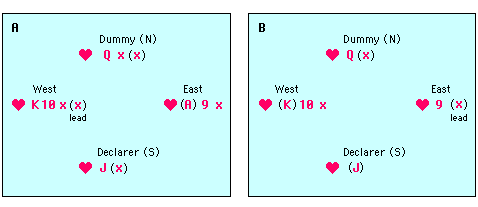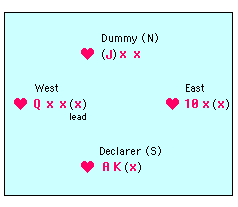Finesse Situation 25 - Free finesse against the Ace and King
As mentioned above, avoid leading this suit yourself.
When an Opponent leads the suit, play LOW both sides (Diagram A), unless they try to win the trick with the 9 or 10.In that case win the trick in the hand that plays last (Declarer's hand in the example below).

When they lead for the next trick play low again (Diagram B), and the third is guarantied yours !
.
(Down - Up - Top)
Finesse Situation 26 - Free finesse against the Queen
West leads 4th highest from his longest suit headed by the Queen. Not an unreasonable lead, but it presents a potential gift to Declarer.
Play the Jack from Dummy for a free finesse. It was never going to make a trick, but if West holds the Queen (as in the Diagram below) it wins an unexpected extra trick.

(Down - Up - Top)
Finesse Situation 27 - Free finesse against the Queen and Jack
Once again West leads the 4th highest from his long suit. Dummy plays LOW again, East plays the Jack which is captured by Declarer's Ace (Diagram A)

Declarer can now finesse against the Queen by playing a small Heart (or the 9) to Dummy's K 10 tenace.
Notice something familiar about this diagram ?
Yes of course, apart from the suit lengths it is the same as in Finesse Situation 25 but turned 90 degrees. Whichever side leads this suit first will give a trick away to the Opponents.
It is a powerful example of the general rule :
When the top four honours are divided equally over the four hands, the side
that leads the suit first will give away an extra trick to their Opponents ! |